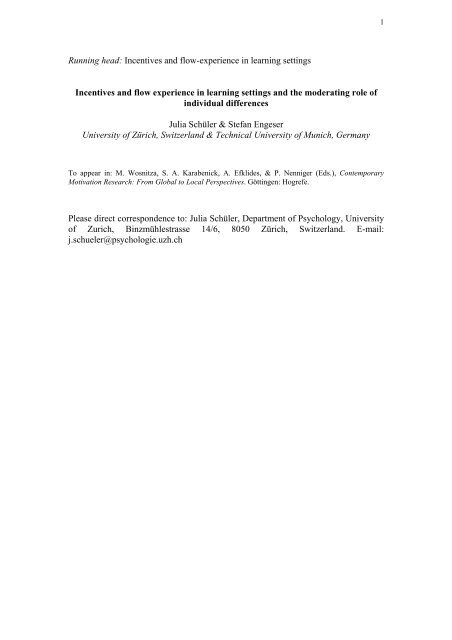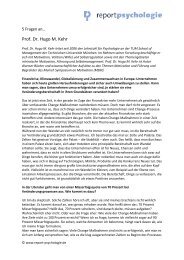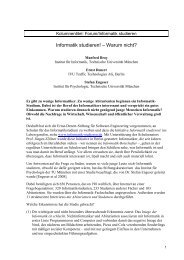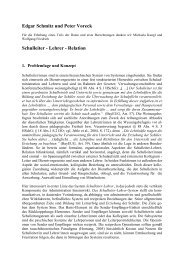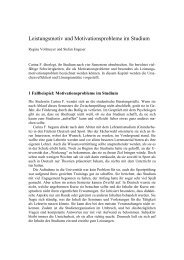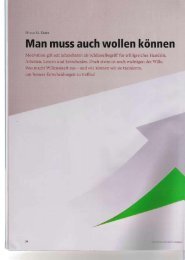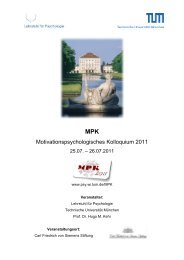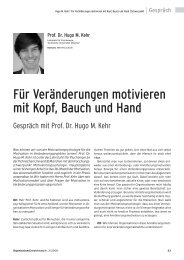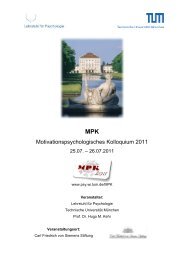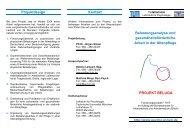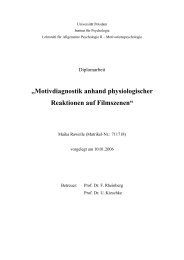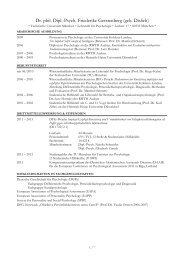Running head: Incentives and flow-experience in learning settings ...
Running head: Incentives and flow-experience in learning settings ...
Running head: Incentives and flow-experience in learning settings ...
- No tags were found...
Create successful ePaper yourself
Turn your PDF publications into a flip-book with our unique Google optimized e-Paper software.
4The latter perspective is taken <strong>in</strong> the Self-Determ<strong>in</strong>ation Theory (SDT) of Deci <strong>and</strong>Ryan (1985). The authors assume that the need for autonomy (see also DeCharms,1968), the need for competence (see also White, 1959) <strong>and</strong> the need for socialrelatedness are <strong>in</strong>nate human needs <strong>and</strong> that basic need satisfaction leads to wellbe<strong>in</strong>gwhereas frustration of basic needs results <strong>in</strong> unhapp<strong>in</strong>ess (Deci & Ryan, 1985;Ryan & Deci, 2000). Accord<strong>in</strong>g to the SDT, the basic needs can be satisfied <strong>in</strong>various situations provided they offer the opportunity to feel autonomous, competent,or socially related. The <strong>in</strong>centives for the person are derived from the <strong>in</strong>teraction ofthe three basic needs with situational or personal variables. For example, the <strong>in</strong>centiveto feel proud <strong>in</strong> sports is based on the human need for competence <strong>and</strong> on the<strong>in</strong>dividual <strong>in</strong>terest for sports. The reason why people get <strong>in</strong>volved <strong>in</strong> sport activities ornot lies <strong>in</strong> the expected feel<strong>in</strong>g of be<strong>in</strong>g proud or not be<strong>in</strong>g proud <strong>in</strong> this case.Most theorists conceptualize goals as cognitive representations of desiredfuture states; for example, there are personal goals (Brunste<strong>in</strong>, Schultheiss, &Grässmann, 1998) or achievement goals (Dweck, 1996; Elliot, 2005). Goals aremanifestations of motives or “<strong>in</strong>dividualized <strong>in</strong>stantiations” of higher-order motives(Emmons, 1989, p. 95). They are an <strong>in</strong>termediate step that l<strong>in</strong>ks the abstract motive(e.g., achievement motive) with concrete behaviour (e.g., practic<strong>in</strong>g for a sportcontest) (Brunste<strong>in</strong> et al., 1998; Elliot & Thrash, 2001) <strong>and</strong> therewith contribute tomotive satisfaction. One could argue that both <strong>in</strong>centives <strong>and</strong> goals are results of an<strong>in</strong>teraction process between motives <strong>and</strong> situational stimuli. But it is important to notethat both constructs capture different aspects of the motivational process. A goal is adesired end state that normally has various <strong>in</strong>centives. A student may strive for a goodgrade (goal) because s/he wants to achieve (motive) <strong>and</strong> because achievement willmake him/her proud of him/herself, or because s/he needs it for job applications, orbecause s/he wants to avoid negative appraisal from his parents (<strong>in</strong>centives). These<strong>in</strong>centives are the reason why the person strives for this goal. The goal aga<strong>in</strong> can beseen as a means to reach the <strong>in</strong>centives.2.2. <strong>Incentives</strong> <strong>in</strong> classic approaches to motivationA classical approach to motivation is to consider motives <strong>and</strong> needs <strong>and</strong> to analyzetheir <strong>in</strong>terplay with <strong>in</strong>centives. Accord<strong>in</strong>g to this classical approach <strong>in</strong>centives are atthe core of the motivation process <strong>and</strong> the reason for action. Another approachstresses the role of expectancies <strong>in</strong> the motivation process (B<strong>and</strong>ura, 1997). Yet,another approach considers <strong>in</strong>centives as well as expectancies (e.g., expectancy-valuemodels; see Eccles & Wigfield, 2002). In this section, we <strong>in</strong>troduce the Risk Tak<strong>in</strong>gModel (Atk<strong>in</strong>son, 1957) <strong>and</strong> the Exp<strong>and</strong>ed Cognitive Model of Motivation(Rhe<strong>in</strong>berg, 2008). The Risk Tak<strong>in</strong>g Model is <strong>in</strong>fluential <strong>in</strong> research on achievementmotivation (see Brunste<strong>in</strong> & Heckhausen, 2008) <strong>and</strong> will be used later on when wepresent <strong>and</strong> discuss f<strong>in</strong>d<strong>in</strong>gs from research on <strong>flow</strong> <strong>experience</strong>. We also refer to theExp<strong>and</strong>ed Cognitive Model of Motivation because it dist<strong>in</strong>guishes two types of<strong>in</strong>centives that are located at different po<strong>in</strong>ts with<strong>in</strong> the motivational process.Atk<strong>in</strong>son’s (1957) Risk Tak<strong>in</strong>g Model is mak<strong>in</strong>g predictions about the choiceof task difficulty. Accord<strong>in</strong>g to the model the choice depends on <strong>in</strong>centives related tothe task achievement <strong>and</strong> on the expectancy that the task can be achieved. <strong>Incentives</strong><strong>and</strong> expectancies are <strong>in</strong>terrelated <strong>in</strong> the achievement context. For an easy task <strong>in</strong>which achievement is very probable (high expectancy) the <strong>in</strong>centive is low. There isless reason for be<strong>in</strong>g proud when hav<strong>in</strong>g achieved a task that everybody else wouldhave achieved easily. Vice versa, for a difficult task the <strong>in</strong>centive is high, but the
9<strong>in</strong>volvement <strong>in</strong> an activity) as well as affective <strong>experience</strong> qualities. This multifacetedcharacter of <strong>flow</strong> br<strong>in</strong>gs along a broad variety of consequences such as enhancedmotivation, high performance <strong>and</strong> well-be<strong>in</strong>g. Thus, because of its positive affectivequality, “the phenomenological <strong>experience</strong> of <strong>flow</strong> is a powerful motivat<strong>in</strong>g force”(Csikszentmihalyi et al., 2005, p. 602) work<strong>in</strong>g as a reward that enhances thelikel<strong>in</strong>ess to perform the rewarded activity aga<strong>in</strong> <strong>and</strong> the competences <strong>in</strong> perform<strong>in</strong>gthe activity further improve. Additionally, some characteristics of <strong>flow</strong> <strong>experience</strong>,such as high concentration <strong>and</strong> high sense of control, directly foster performance.Several studies confirmed that <strong>flow</strong> <strong>experience</strong> predicts academic or workperformance (Eisenberger, Jones, St<strong>in</strong>glhamber, Shanock, & R<strong>and</strong>all, 2005; Engeseret al., 2005), learn<strong>in</strong>g behavior (Cskiszentmihalyi, Rathunde, & Whalen, 1993; Lee,2005) <strong>and</strong> creativity (Perry, 1999; Sawyer, 1992). For example, Engeser et al. (2005)measured the <strong>flow</strong> <strong>experience</strong> of students at the beg<strong>in</strong>n<strong>in</strong>g of a semester dur<strong>in</strong>g alesson of a foreign language course <strong>and</strong> an elementary statistics course <strong>and</strong> found thatit predicted exam performance at the end of the semester, even when skill wascontrolled for. Also studies <strong>in</strong> the doma<strong>in</strong> of sport revealed associations between <strong>flow</strong><strong>experience</strong> <strong>and</strong> sports performance (Jackson & Roberts, 1992; Jackson, Thomas,Marsh, & Smethurst, 2001; Pates, Karageorghis, Freyer, & Maynard, 2003; Ste<strong>in</strong>,Kimiecik, Daniels, & Jackson, 1995).Apart from hav<strong>in</strong>g a positive effect on motivation <strong>and</strong> performance, Moneta<strong>and</strong> Csikszentmihalyi (1996, p. 277) stated that <strong>flow</strong> is a psychological state “[…] <strong>in</strong>which the person feels simultaneously cognitively efficient, motivated <strong>and</strong> happy”<strong>and</strong> Csikszentmihalyi (1999; Csikszentmihalyi et al., 1993) added that repeated<strong>experience</strong> of <strong>flow</strong> has a pervasive <strong>in</strong>cremental effect on positive mood. Empiricalresearch confirmed that <strong>flow</strong> <strong>experience</strong> is associated with positive affect dur<strong>in</strong>g awork<strong>in</strong>g day (Csikszentmihalyi & LeFevre, 1989) <strong>and</strong> <strong>in</strong> an academic learn<strong>in</strong>gcontext (Schüler, 2007). Given the importance of <strong>flow</strong> for motivation, performance<strong>and</strong> well-be<strong>in</strong>g, it is <strong>in</strong>terest<strong>in</strong>g to have a closer look at its antecedents.3.1. The antecedents of <strong>flow</strong> <strong>experience</strong>Antecedents of <strong>flow</strong> <strong>experience</strong> can be analyzed by either tak<strong>in</strong>g a “global”perspective by assum<strong>in</strong>g that conditions are generally valid for all <strong>in</strong>dividuals or bytak<strong>in</strong>g a “local” perspective argu<strong>in</strong>g that some conditions are valid for some<strong>in</strong>dividuals under some circumstances, but not for others. We will discuss bothperspectives separately <strong>and</strong> will then outl<strong>in</strong>e how global <strong>and</strong> specific conditions canbe considered simultaneously.3.1.1. “Global” antecedents of <strong>flow</strong> <strong>experience</strong>Three global conditions are of key importance for the <strong>flow</strong> <strong>experience</strong>(Csikszentmihalyi et al., 2005). The first is the clarity of the goal. At first sight thisdoes not seem compatible with the conceptualization of <strong>flow</strong> as an activity-related<strong>in</strong>centive, because a goal is <strong>in</strong> essence a focus on the action result. But tak<strong>in</strong>g a closerlook it seems plausible: Clear goals direct behavior <strong>and</strong> help to focus attention ongoal-relevant behavior. This aga<strong>in</strong> facilitates gett<strong>in</strong>g absorbed by the action <strong>and</strong>focuss<strong>in</strong>g all energy <strong>and</strong> attention that otherwise would get lost. Goals structure theactivity without be<strong>in</strong>g the only or the actual reason for perform<strong>in</strong>g the activity, <strong>and</strong> bythis, they foster <strong>flow</strong> (Rhe<strong>in</strong>berg, Manig, Kliegl, Engeser, & Vollmeyer, 2007). Thesecond global condition is clear <strong>and</strong> immediate feedback. Feedback signals whether a
3.1.2. “Local” antecedents of <strong>flow</strong> <strong>experience</strong>In this section we take a “local” perspective on <strong>flow</strong> antecedents byconsider<strong>in</strong>g <strong>in</strong>dividual differences. We will discuss the autotelic personality,motivational competence, self-concept, <strong>and</strong> self-regulation skills.Csikszentmihalyi showed that <strong>in</strong>dividuals generally differ <strong>in</strong> the <strong>in</strong>tensity <strong>and</strong>frequency with which they <strong>experience</strong> <strong>flow</strong> (Csikszentmihalyi & Csikszentmihalyi,1988). Csikszentmihalyi <strong>and</strong> Rathunde (1992) suggested that an autotelic personalitymight expla<strong>in</strong> these <strong>in</strong>dividual differences. “An autotelic person is one who f<strong>in</strong>ds<strong>in</strong>tr<strong>in</strong>sic motivation <strong>and</strong> <strong>flow</strong> <strong>in</strong> everyday life […], who f<strong>in</strong>ds enjoyment <strong>in</strong> activitiesthat would make others bored or anxious” (Csikszentmihalyi & Rathunde, 1992, p.88). A longitud<strong>in</strong>al study with talented teenagers revealed that students who scoredhigh on the personality factors achievement motive, endurance, sentience <strong>and</strong>underst<strong>and</strong><strong>in</strong>g reported more <strong>flow</strong> dur<strong>in</strong>g the week. Csikszentmihalyi <strong>and</strong> Rathunde(1992) suggested that those personality factors are similar to the autotelic qualities ofbe<strong>in</strong>g energetic <strong>and</strong> capable, <strong>and</strong> be<strong>in</strong>g open to new challenges (Csikszentmihalyi &Rathunde, 1992). In order to specify Csikszentmihalyi’s description of an “autotelicpersonality”, Kimiecik <strong>and</strong> Jackson (2002, p. 515) def<strong>in</strong>ed the autotelic person as an<strong>in</strong>dividual who generally does th<strong>in</strong>gs for their own sake, rather than to achieve somelater external goals (Kimiecik & Jackson, 2002, p. 515). They studied <strong>flow</strong> <strong>experience</strong><strong>in</strong> sportsmen <strong>and</strong> sportswomen <strong>and</strong> suggested that dispositional factors constitute anautotelic personality. They suggested that task orientation (rather than egoorientation), high perceived ability, low trait anxiety, <strong>and</strong> high <strong>in</strong>tr<strong>in</strong>sic motivation(operationalized by a high need for autonomy accord<strong>in</strong>g to Deci & Ryan, 1985) arerelated to <strong>flow</strong> <strong>experience</strong> (Jackson, Kimiecik, Ford, & Marsh, 1998). However, theauthors critically mentioned that their “[…] f<strong>in</strong>d<strong>in</strong>gs lend credence to the notion thatsometh<strong>in</strong>g ak<strong>in</strong> to autotelic personality may exist“ (p. 517), but that “we have a longway to go, however, <strong>in</strong> figur<strong>in</strong>g out the role of personality factors <strong>in</strong> underst<strong>and</strong><strong>in</strong>goptimal <strong>experience</strong> <strong>in</strong> sport” (p. 517).Another personal feature that can expla<strong>in</strong> <strong>in</strong>dividual differences <strong>in</strong> <strong>flow</strong><strong>experience</strong> is “motivational competence” (Rhe<strong>in</strong>berg, 2008). It is def<strong>in</strong>ed as theability to reconcile current <strong>and</strong> future situations with activity preferences enabl<strong>in</strong>g the<strong>in</strong>dividual to function efficiently, without the need for permanent volitional control”(Rhe<strong>in</strong>berg, 2002). The most important component of motivational competence is anaccurate sense of one’s own implicit motives (Rhe<strong>in</strong>berg, 2008). Know<strong>in</strong>g one’simplicit motives enables to br<strong>in</strong>g one’s motivational self-concept (or explicit motive,see McClell<strong>and</strong>, Koestner, & We<strong>in</strong>berger, 1989) <strong>in</strong>to agreement with the implicitmotives. This facilitates the sett<strong>in</strong>g of goals that fit to both motive systems. Goalstriv<strong>in</strong>gwhich is based on motive congruence guarantees the absence of volitionalcontrol <strong>and</strong> the presence of activity-related <strong>in</strong>centives, which are both beneficial forthe <strong>experience</strong> of <strong>flow</strong>. In contrast, if the implicit <strong>and</strong> explicit motive systems are<strong>in</strong>congruent, <strong>in</strong>dividuals are likely to set goals that do not fit their implicit motives<strong>and</strong> thus h<strong>in</strong>der <strong>flow</strong> dur<strong>in</strong>g goal-striv<strong>in</strong>g. Empirical support for the <strong>flow</strong> hypothesisof motivational competence (see Rhe<strong>in</strong>berg, 2008) was provided by Clavadetscher(2003) who was <strong>in</strong>terested <strong>in</strong> the <strong>flow</strong> <strong>experience</strong> of voluntary workers <strong>and</strong> found that<strong>in</strong>dividuals with congruent implicit <strong>and</strong> self-reported motives reported a higheramount of <strong>flow</strong> <strong>experience</strong> than <strong>in</strong>dividuals with <strong>in</strong>congruent motives. Engeser et al.(2005) showed that students of a statistics course whose implicit achievement motivewas high <strong>and</strong> congruent with a high self-attributed achievement motive could betterself-regulate their behavior. They could better identify themselves with their actions11
12<strong>and</strong> were more likely to feel absorbed by the action. Thus, <strong>in</strong>dividual differences <strong>in</strong>motivational competence revealed to be an important determ<strong>in</strong>ant of <strong>flow</strong> <strong>experience</strong>.Jackson et al. (2001) <strong>in</strong>vestigated <strong>flow</strong> <strong>experience</strong> <strong>in</strong> sports. They focused onthe athletic self-concept <strong>and</strong> self-regulation skills as personal determ<strong>in</strong>ants of <strong>flow</strong><strong>experience</strong>. A positive athletic self-concept (e.g., regard<strong>in</strong>g mental competence,overall performance <strong>and</strong> skills) was expected to be a <strong>flow</strong> predictor, due to theenhanced confidence <strong>in</strong> one’s actions. In an earlier study the related construct ofperceived ability was shown to be positively associated with <strong>flow</strong> <strong>experience</strong> (e.g.,Jackson & Roberts, 1992). Self-regulation skills (e.g., emotional control, relaxation,self talk) should also be connected to <strong>flow</strong> <strong>experience</strong>, because their effective usemeans a greater control over one’s thoughts <strong>and</strong> emotions. Hence, concentration onthe sport activity itself should be facilitated. Jackson et al. (2001) studied athletes ofdifferent competitive sports <strong>and</strong> found that the athletic self-concept as well as the selfregulationskills was associated with <strong>flow</strong> <strong>experience</strong>.3.1.3. The consideration of global <strong>and</strong> local perspectives on <strong>flow</strong> antecedentsThe previous paragraphs showed two perspectives that can be taken to analyzeantecedents of <strong>flow</strong> <strong>experience</strong>. On the one h<strong>and</strong>, there is the perspective of global(i.e., universally valid) antecedents, as for example, unambiguous feedback or theclarity of goals. On the other h<strong>and</strong>, <strong>flow</strong> <strong>experience</strong> is to some extent determ<strong>in</strong>ed by<strong>in</strong>dividual differences <strong>in</strong> the preference for situations that can br<strong>in</strong>g about <strong>flow</strong><strong>experience</strong>, such as personality characteristics <strong>and</strong> motivational competences. Thisparagraph simultaneously considers a local <strong>and</strong> a global perspective.As mentioned above, Csikszentmihalyi (1975, 1999; Csikszentmihalyi et al.,2005) postulated that the challenge-skill balance is an important determ<strong>in</strong>ant of <strong>flow</strong><strong>experience</strong>. The balance of challenges <strong>and</strong> skills is associated with <strong>flow</strong> <strong>experience</strong>,whereas the imbalance leads to negative <strong>experience</strong> (anxiety, boredom). Thisrelationship between challenge-skill balance, on the one h<strong>and</strong>, <strong>and</strong> <strong>flow</strong> <strong>experience</strong>,on the other, was formulated as global regularity that was assumed to be valid for all<strong>in</strong>dividuals. Empirical evidence, however, showed that this regularity does not alwayshold. Studies <strong>in</strong>vestigat<strong>in</strong>g the relationship between challenge-skill balance <strong>and</strong> <strong>flow</strong><strong>experience</strong> yield <strong>in</strong>consistent results (Ellis, Voelkl, & Morris, 1994; Engeser &Rhe<strong>in</strong>berg, 2008; Schüler, 2007; Stoll & Lau, 2005). Rhe<strong>in</strong>berg (2008; see also Stoll& Lau, 2005) suggested that these <strong>in</strong>consistencies might be expla<strong>in</strong>ed by moderatorvariables.A moderator that might expla<strong>in</strong> why some <strong>in</strong>dividuals <strong>experience</strong> <strong>flow</strong> whenthere is a challenge-skill balance, whereas others do not, is the achievement motive(Engeser & Rhe<strong>in</strong>berg, 2008; Rhe<strong>in</strong>berg, Vollmeyer, & Engeser, 2003; Schüler,2007). With Atk<strong>in</strong>son’s (1957) Risk Tak<strong>in</strong>g Model we already <strong>in</strong>troduced atheoretical framework l<strong>in</strong>k<strong>in</strong>g the achievement motive to the challenge-skill balance<strong>and</strong> its consequences. The Risk Tak<strong>in</strong>g Model assumes that <strong>in</strong>dividuals with hope ofsuccess <strong>and</strong> fear of failure both have the desire «to overcome obstacles, to exercisepower, to strive to do someth<strong>in</strong>g difficult as well <strong>and</strong> as quickly as possible» (Murray,1938, pp. 80-81) <strong>and</strong> want to surpass personal st<strong>and</strong>ards of excellence (McClell<strong>and</strong> etal., 1953). The ma<strong>in</strong> difference between <strong>in</strong>dividuals motivated by hope of success <strong>and</strong>fear of failure is that the former prefer moderately difficult tasks whereas <strong>in</strong>dividualswith fear of failure feel more comfortable with tasks that are either too easy or toodifficult. The l<strong>in</strong>k between Atk<strong>in</strong>son’s conceptualization of task difficulty <strong>and</strong>Csikszentmihalyi’s challenge-skill balance follows a clear rationale. A moderately
difficult task which is preferred by <strong>in</strong>dividuals motivated by hope of success can be<strong>in</strong>terpreted as a task where the challenges of the situation can be faced with adequatepersonal skills. Analogously, tasks that are either too difficult or too easy (preferredby <strong>in</strong>dividuals motivated by fear of failure) are characterized by an imbalance ofchallenge <strong>and</strong> skill. Integrat<strong>in</strong>g both theories, a challenge-skill balance should lead tohigher motivation only for <strong>in</strong>dividuals who are high <strong>in</strong> hope of success, whereas itdoes not arouse higher motivation for <strong>in</strong>dividuals with fear of failure. For the latter,be<strong>in</strong>g <strong>in</strong> a challenge-skill balance arouses anxiety that is known to h<strong>in</strong>der <strong>flow</strong><strong>experience</strong> (Csikszentmihalyi, 1990; Jackson, 1995). Thus, only <strong>in</strong>dividuals with hopeof success are assumed to <strong>experience</strong> <strong>flow</strong> when a perceived challenge-skill balance isgiven; <strong>in</strong>dividuals motivated by fear of failure are expected to report the absence of<strong>flow</strong> <strong>experience</strong> when they are <strong>in</strong> a challenge-skill balance situation.Eisenberger et al. (2005) applied Csikszentmihalyi’s (1990) <strong>flow</strong> theory to theworkplace <strong>and</strong> found support for the moderat<strong>in</strong>g role of the achievement motive.They found that among employees with a high need for achievement the <strong>experience</strong>of high skills <strong>and</strong> challenges of a job task was related to a better mood, task <strong>in</strong>terest,<strong>and</strong> organizational spontaneity. Employees with a low need for achievement,however, showed no such correlation. Although it could be criticized that <strong>flow</strong><strong>experience</strong> was only measured <strong>in</strong>directly by assess<strong>in</strong>g task <strong>in</strong>terest, the f<strong>in</strong>d<strong>in</strong>gs aregenerally consistent with the assumption of the achievement motive as a moderator ofthe challenge-skill balance <strong>and</strong> a motivational state comparable to <strong>flow</strong> <strong>experience</strong>.Schüler (2007) found evidence for the moderat<strong>in</strong>g function of the achievementmotive <strong>in</strong> an academic learn<strong>in</strong>g sett<strong>in</strong>g. In two studies the hope-of-success motive <strong>and</strong>the fear-of-failure motive were measured among undergraduate students us<strong>in</strong>g theMulti-Motive-Grid (MMG; Sokolowski, Schmalt, Langens, & Puca, 2000) which wasproven to be a highly economic, reliable <strong>and</strong> valid measurement of motives (Gable,Reis, & Elliot, 2003; Sokolowski et al., 2000). In an elementary course <strong>in</strong> psychologythe students were asked whether the challenge of course contents was either too lowfor their skills, too high for their skills, or whether it fitted their skills. Then,participants’ <strong>experience</strong> of <strong>flow</strong> dur<strong>in</strong>g the course lectures was registered byadm<strong>in</strong>ister<strong>in</strong>g the Flow Short Scale (Flow Kurz Skala, FKS; Rhe<strong>in</strong>berg et al., 2003),which showed high reliability <strong>and</strong> validity <strong>in</strong> several studies (see Rhe<strong>in</strong>berg et al.,2003). Items <strong>in</strong>cluded “My thoughts run fluidly <strong>and</strong> smoothly”, “I am totally absorbed<strong>in</strong> what I am do<strong>in</strong>g” <strong>and</strong> “I am completely lost <strong>in</strong> thought” <strong>and</strong> were rated us<strong>in</strong>g a 7-po<strong>in</strong>t scale (from “not at all” to “very much”). As expected, participants whosechallenges <strong>and</strong> skills were <strong>in</strong> a balance <strong>and</strong> who additionally had a high score <strong>in</strong> hopeof success reported high amount of <strong>flow</strong> <strong>experience</strong>. Students with high scores <strong>in</strong> fearof failure <strong>experience</strong>d the lowest amount of <strong>flow</strong> <strong>experience</strong> when a challenge-skillbalance was given.Engeser <strong>and</strong> Rhe<strong>in</strong>berg (2008) extended previous research by us<strong>in</strong>g a directmeasurement of <strong>flow</strong> <strong>in</strong> longitud<strong>in</strong>al studies. Assum<strong>in</strong>g that <strong>flow</strong> is a transient stateoccurr<strong>in</strong>g dur<strong>in</strong>g the activity itself, the authors measured students’ <strong>flow</strong> <strong>experience</strong>directly while the learn<strong>in</strong>g activity was performed. The <strong>flow</strong> measurement at the endof the semester was expected to be predicted by the hope-of-success measure (PictureStory Exercise; Pang & Schultheiss, 2005) <strong>and</strong> the fear-of-failure measure (GermanVersion of the Achievement Motives Scale; Dahme, Jungnickel, & Rathje 1993),which were adm<strong>in</strong>istered at the beg<strong>in</strong>n<strong>in</strong>g of the semester. As expected, when thechallenge of the task was rated “just right” ― an example item is “I th<strong>in</strong>k that mycompetence <strong>in</strong> this area is 1 (too low) / 5 (just right) / 9 (too high) ― <strong>flow</strong> <strong>experience</strong>13
14was high for highly <strong>in</strong> hope-of-success motivated <strong>in</strong>dividuals. In contrast studentswith fear of failure reported low scores of <strong>flow</strong> <strong>experience</strong> <strong>in</strong> a situation withchallenge-skill balance. Aga<strong>in</strong>, the relationship between the challenge-skill balance<strong>and</strong> <strong>flow</strong> <strong>experience</strong> was moderated by <strong>in</strong>dividual differences <strong>in</strong> the achievementmotive.The results of the cited studies strongly recommend consider<strong>in</strong>g a localperspective on motivation (<strong>in</strong>dividual differences <strong>in</strong> <strong>in</strong>teraction with specialsituations) when analyz<strong>in</strong>g the relationship between a global predictor (challenge-skillbalance) <strong>and</strong> <strong>flow</strong> <strong>experience</strong>. Further research that considers a global as well as alocal perspective on <strong>flow</strong>-<strong>experience</strong> antecedents will be needed to enhance theunderst<strong>and</strong><strong>in</strong>g of the <strong>in</strong>terplay of global <strong>and</strong> specific conditions.4. Summary <strong>and</strong> practical implicationsIn this chapter, we elaborated the concept of <strong>in</strong>centives by <strong>in</strong>troduc<strong>in</strong>g the dist<strong>in</strong>ction<strong>in</strong>to activity-related <strong>and</strong> purpose-related <strong>in</strong>centives (Rhe<strong>in</strong>berg, 1989, 2008). We thenfocused on <strong>flow</strong> <strong>experience</strong> which constitutes a prom<strong>in</strong>ent representative of anactivity-related <strong>in</strong>centive <strong>and</strong> exam<strong>in</strong>ed its antecedents <strong>and</strong> consequences.The theoretical separation <strong>in</strong>to activity-related <strong>and</strong> purpose-related <strong>in</strong>centivesas well as a detailed knowledge of <strong>flow</strong> conditions has important practicalimplications for educational sett<strong>in</strong>gs. Assum<strong>in</strong>g that alongside purpose-relatedlearn<strong>in</strong>g <strong>in</strong>centives (e.g., compliments <strong>and</strong> grades) a second source of <strong>in</strong>centivesexists provides the opportunity to enhance the <strong>in</strong>centive <strong>in</strong>tensity of a learn<strong>in</strong>gcontext. Because activities with only purpose-related <strong>in</strong>centives are much easier todisrupt than activities done for their own sake, it is helpful to enrich learn<strong>in</strong>g sett<strong>in</strong>gswith activity-related <strong>in</strong>centives. It is crucial to note that this does not mean thatpurpose-related <strong>in</strong>centives are unimportant. Even if activity-related <strong>in</strong>centives yield amore robust form of motivation the most robust form is when activity- <strong>and</strong> purposerelated<strong>in</strong>centives are both given simultaneously. An example is a high enjoymentwhile prepar<strong>in</strong>g for an exam <strong>and</strong> additionally be<strong>in</strong>g proud after achiev<strong>in</strong>g a goodgrade.In what follows we speculate about some start<strong>in</strong>g po<strong>in</strong>ts <strong>and</strong> general advicesfor the enhancement of the activity-related <strong>in</strong>centive of <strong>flow</strong> <strong>experience</strong>. With <strong>flow</strong>, arobust form of motivation is created, which rema<strong>in</strong>s present even if the control byexternal dem<strong>and</strong>s or rewards (e.g., exam grades, controll<strong>in</strong>g teachers) is miss<strong>in</strong>g <strong>and</strong>even if the persons’ expectancies to achieve a goal state are low (see above: activityrelated<strong>in</strong>centives do not need any outcome expectancies!).Csikszentmihalyi (1990) proposed that the clarity of the goal, clear immediatefeedback, <strong>and</strong> challenge-<strong>and</strong>-skill balance are critical preconditions for <strong>flow</strong><strong>experience</strong>. The new conceptualization provided by our research is that therelationship between the challenge-skill balance <strong>and</strong> <strong>flow</strong> <strong>experience</strong> is moderated bya personal variable (the achievement motive) <strong>and</strong> by a more situation-specificvariable, that is, the <strong>in</strong>strumentality of an activity. Herewith we differentiated betweena global perspective on <strong>flow</strong> antecedents (e.g., clear goals <strong>and</strong> feedback) <strong>and</strong> a localperspective (e.g., achievement motive, <strong>in</strong>strumentality).Our results showed that <strong>in</strong>dividuals with hope of success, but not with fear offailure, <strong>experience</strong>d <strong>flow</strong> when they were <strong>in</strong> an achievement situation characterizedby challenge-skill balance. In contrast, <strong>in</strong>dividuals with fear of failure <strong>experience</strong>d<strong>flow</strong> when the task was either too difficult or too easy for their skills. For educational
sett<strong>in</strong>gs these results mean that <strong>in</strong> order to evoke <strong>flow</strong> <strong>experience</strong> <strong>in</strong> students, eitherthe challenge-skill balance can be adapted to students motive or the motives can bechanged <strong>in</strong> that way that they fit with the challenge-skill balance condition. It isimportant to note that both ways are just theoretical speculations unless empiricalevidence for their efficacy is supplied, but nevertheless they might <strong>in</strong>spire a new viewon educational sett<strong>in</strong>gs.Adapt<strong>in</strong>g the challenge-skill balance condition to a person’s motive would bea new strategy that has not been used so far with<strong>in</strong> the achievement motivationresearch. With this strategy it would be possible to motivate students. Facilitat<strong>in</strong>g<strong>flow</strong> <strong>experience</strong> <strong>in</strong> students with fear of failure is a desirable pedagogical aim but, onthe other h<strong>and</strong>, provid<strong>in</strong>g a student with too easy or too difficult tasks (which areoptimally <strong>flow</strong>-aris<strong>in</strong>g for students with fear of failure) is <strong>in</strong> conflict with the <strong>in</strong>creaseof competences <strong>and</strong> knowledge. The <strong>in</strong>crease of competence <strong>and</strong> knowledge dependson realistic dem<strong>and</strong>s that are not given for <strong>in</strong>dividuals <strong>in</strong> a challenge-skill imbalancesituation. Therefore, <strong>in</strong> the long run, it makes much more sense to make a student feelcomfortable with challenge-skill balanced tasks. This second implication requiresmodify<strong>in</strong>g a students’ motive <strong>in</strong> a way that it <strong>in</strong>teracts optimally with challenge-skillbalance.Chang<strong>in</strong>g motives is a complex procedure, because motives are conceptualizedas characteristics, which, once they are developed, are relatively stable across the lifespan <strong>and</strong> that are difficult to <strong>in</strong>fluence by the social environment (McClell<strong>and</strong>, 1985).Nevertheless, sophisticated <strong>in</strong>tervention programs showed that it is still possible tochange motives to some degree. Intervention programs that have been proven to behighly effective mostly reduce fear of failure (rather than enhance hope of success);for example by tra<strong>in</strong><strong>in</strong>g realistic goal sett<strong>in</strong>g <strong>and</strong> teach<strong>in</strong>g beneficial attributions forsuccess <strong>and</strong> failure (Krug & Hanel, 1976; for an overview see Rhe<strong>in</strong>berg & Engeser,<strong>in</strong> press; Rhe<strong>in</strong>berg & Krug, 2005). With effective motive modification programs,fear of failure with its negative consequences (e.g., the negative consequences on <strong>flow</strong><strong>experience</strong> <strong>in</strong> case of a challenge-skill balance situation) can be reduced so that aga<strong>in</strong>the development of students’ skills <strong>and</strong> well-be<strong>in</strong>g are enhanced.Consider<strong>in</strong>g the <strong>in</strong>strumentality of a task as a moderator with<strong>in</strong> the challengeskillbalance <strong>and</strong> <strong>flow</strong> relationship could also have <strong>in</strong>terest<strong>in</strong>g practical implications.Regard<strong>in</strong>g Engeser <strong>and</strong> Rhe<strong>in</strong>berg’s (2008) results, challenge-skill balance is optimalto <strong>experience</strong> <strong>flow</strong> <strong>in</strong> activities of low <strong>in</strong>strumentality, whereas for high<strong>in</strong>strumentality tasks the skill should be higher than the challenge of the task.Transferred to teach<strong>in</strong>g practice, it would be best to challenge students with skillfitt<strong>in</strong>gtasks that are not evaluated by the teacher, do not <strong>in</strong>fluence a grade <strong>and</strong> do nothave other important consequences (= low <strong>in</strong>strumentality). For example, such a taskcould be learn<strong>in</strong>g a new topic without be<strong>in</strong>g directed towards an important purposesuch as an exam<strong>in</strong>ation or solv<strong>in</strong>g complex math problems that are not evaluated. Thiscan evoke <strong>flow</strong> <strong>experience</strong> <strong>and</strong> thus learn<strong>in</strong>g motivation <strong>and</strong> performance can beenhanced <strong>and</strong> will help to improve students’ competences. To deal with the fact thatgrades <strong>and</strong> evaluations are part of most pedagogical school systems, teachers couldlower the task challenges when tasks have a high <strong>in</strong>strumentality such as a statisticstest or other k<strong>in</strong>ds of exam<strong>in</strong>ations. This could be done, for example, by lett<strong>in</strong>gstudents practice already well h<strong>and</strong>led operations (e.g., rout<strong>in</strong>e tasks) dur<strong>in</strong>g thepreparation for an exam<strong>in</strong>ation. With this procedure, <strong>flow</strong> can be ma<strong>in</strong>ta<strong>in</strong>ed even <strong>in</strong>necessary exam preparation periods. Additionally, the students can perform on a highlevel due to high competences they achieved by low <strong>in</strong>strumentality tasks they15
16performed before. Teachers may decide whether adapt<strong>in</strong>g task challenges to differentperiods of learn<strong>in</strong>g (learn<strong>in</strong>g new th<strong>in</strong>gs without be<strong>in</strong>g evaluated vs. prepar<strong>in</strong>g for anexam<strong>in</strong>ation) is practical <strong>in</strong> their teach<strong>in</strong>g work.ReferencesAtk<strong>in</strong>son, J. W. (1957). Motivational determ<strong>in</strong>ants of risk tak<strong>in</strong>g behavior.Psychological Review, 64, 359-372.B<strong>and</strong>ura, A. (1997). Self-efficacy: The exercise of control. New York:Freeman.Beckman, J., & Heckhausen, H. (2008). Motivation as a function ofexpectancy <strong>and</strong> <strong>in</strong>centives. In H. Heckhausen & J. Heckhausen (Eds.), Motivation <strong>and</strong>action (pp. 99-136). Cambridge, UK: Cambridge University Press.Brunste<strong>in</strong>, J. C., & Heckhausen, H. (2008). In H. Heckhausen & J.Heckhausen (Eds.), Motivation <strong>and</strong> action (pp. 137-183). Cambridge, UK: CambridgeUniversity Press.Brunste<strong>in</strong>, J. C., Schultheiss, O. C., & Grässmann, R. (1998). Personal goals<strong>and</strong> emotional well-be<strong>in</strong>g: The moderat<strong>in</strong>g role of motive dispositions. Journal ofPersonality <strong>and</strong> Social Psychology, 75, 494-508.Bühler, K. (1922). Die geistige Entwicklung des K<strong>in</strong>des [The mentaldevelopment of the child]. Jena, Germany: Fischer.Clavadetscher, C. (2003). Motivation ehrenamtlicher Arbeit im Vere<strong>in</strong>Mahogany Hall, Bern [Motivation for voluntary work <strong>in</strong> the association MahoganyHall, Bern]. Bern: Abschlussarbeit NDS BWL/UF, Hochschule für Technik undArchitektur.Csikszentmihalyi, M. (1975). Beyond boredom <strong>and</strong> anxiety. San Francisco:Jossey-Bass.Csikszentmihalyi, M. (1990). Flow: The psychology of optimal <strong>experience</strong>.New York: Harper & Row.Csikszentmihalyi, M. (1999). Das Flow-Erlebnis: Jenseits von Angst undLangeweile. [Flow <strong>experience</strong>: Beyond Anxiety <strong>and</strong> Boredom]. Stuttgart, Germany:Klett-Cotta.Csikszentmihalyi, M., Abuhamdeh, S., & Nakamura, J. (2005). Flow. In A. J.Elliot & C. S. Dweck (Eds.), H<strong>and</strong>book of competence <strong>and</strong> motivation (pp. 598-608).New York: Guilford.Csikszentmihalyi, M., & Csikszentmihalyi, I. (1988). Optimal <strong>experience</strong>:Psychological studies of <strong>flow</strong> <strong>in</strong> consciousness. Cambridge, UK: CambridgeUniversity Press.Csikszentmihalyi, M., & Csikszentmihalyi, I. S. (1991). Dieaussergewöhnliche Erfahrung im Alltag: Die Psychologie des Flow-Erlebens[Extraord<strong>in</strong>ary <strong>experience</strong> <strong>in</strong> everyday life: Psychology of <strong>flow</strong> <strong>experience</strong>]. Stuttgart,Germany: Klett-Cotta.Csikszentmihalyi, M., & LeFevre, J. (1989). Optimal <strong>experience</strong> <strong>in</strong> work <strong>and</strong>leisure. Journal of Personality <strong>and</strong> Social Psychology, 56, 815-822.Csikszentmihalyi, M., & Rathunde, K. (1992). The measurement of <strong>flow</strong> <strong>in</strong>everyday life: Toward a theory of emergent motivation. In R. Dienstbier & J. E.Jacobs (Eds.), Nebraska Symposium on motivation (pp. 57-97). L<strong>in</strong>coln, NE:University of Nebraska Press.
Csikszentmihalyi, M., Rathunde, K., & Whalen, S. (1993). Talented teenagers:A longitud<strong>in</strong>al study of their development. New York: Cambridge University Press.Dahme, G., Jungnickel, D., & Rathje, H. (1993). Güteeigenschaften derAchievement Motives Scale (AMS) von Gjesme und Nygard (1970) <strong>in</strong> der deutschenÜbersetzung von Göttert und Kuhl: Vergleich der Kennwerte norwegischer unddeutscher Stichproben [Psychometric <strong>in</strong>dices of the Achievement Motives Scale byGjesme <strong>and</strong> Nygard (1970) <strong>in</strong> the German version by Goettert <strong>and</strong> Kuhl: Acomparison of Norwegian <strong>and</strong> German samples]. Diagnostica, 39, 257-270.DeCharms, R. (1968). Personal causation. New York: Academic.Deci, E. L., & Ryan, R. M. (1980). The empirical exploration of <strong>in</strong>tr<strong>in</strong>sicmotivational processes. In L. Berkowitz (Ed.), Advances <strong>in</strong> experimental socialpsychology (pp. 39- 80). New York: Academic.Deci, E. L., & Ryan, R. M. (1985). Intr<strong>in</strong>sic motivation <strong>and</strong> self-determ<strong>in</strong>ation<strong>in</strong> human behavior. New York: Plenum.Dweck, C. (1996). Captur<strong>in</strong>g the dynamic nature of personality. Journal ofResearch <strong>in</strong> Personality, 30, 348-362.Eccles, J. S., & Wigfield, A. (2002). Motivational beliefs, values, <strong>and</strong> goals.Annual Review of Psychology, 53, 109-132.Eisenberger, R., Jones, J. R., St<strong>in</strong>glhamber, F., Shanock, L., & R<strong>and</strong>all, A. T.(2005). Flow <strong>experience</strong>s at work: For high need achievers alone? Journal ofOrganizational Behavior, 26, 755-775.Elliot, A. J. (2005). A conceptual history of the achievement goal construct. InA. J. Elliot & C. S. Dweck (Eds.), H<strong>and</strong>book of competence <strong>and</strong> motivation (pp. 52-72). New York: Guilford.Elliot, A. J., & Harackiewicz, J.M. (1996). Approach <strong>and</strong> avoidanceachievement goals <strong>and</strong> <strong>in</strong>tr<strong>in</strong>sic motivation. A mediational analysis. Journal ofPersonality <strong>and</strong> Social Psychology, 70, 461-475.Elliot, A. J., & Thrash, T. M. (2001). Achievement goals <strong>and</strong> the hierarchicalmodel of achievement motivation. Educational Psychology Review, 13(2), 139-156.Ellis, G. D., Voelkl, J. E., & Morris, C. (1994). Measurements <strong>and</strong> analysisissues with explanation of variance <strong>in</strong> daily expierience us<strong>in</strong>g the <strong>flow</strong> model. Journalof Leisure Research, 26, 337-356.Emmons, R.A. (1989). The personal striv<strong>in</strong>g approach to personality <strong>and</strong>subjective well-be<strong>in</strong>g. In L. A. Perv<strong>in</strong> (Ed.), Goal concepts <strong>in</strong> personality <strong>and</strong> socialpsychology (pp. 87-126). Hillsdale, NJ: Erlbaum.Engeser, S., & Rhe<strong>in</strong>berg, F. (2008). Flow, performance, <strong>and</strong> moderators ofchallenge-skill balance. Manuscript submitted for publication.Engeser, S., Rhe<strong>in</strong>berg, F., Vollmeyer, R., & Bischoff, J. (2005). Motivation,Flow-Erleben und Lernleistung <strong>in</strong> universitären Lernsett<strong>in</strong>gs [Motivation, <strong>flow</strong><strong>experience</strong> <strong>and</strong> performance <strong>in</strong> learn<strong>in</strong>g sett<strong>in</strong>gs at university]. Zeitschrift fürPädagogische Psychologie, 19, 159-172.Gable, S. L., Reis, H. T., & Elliot, A. J. (2003). Evidence for bivariatesystems: An empirical test of appetition <strong>and</strong> aversion across doma<strong>in</strong>s. Journal ofResearch <strong>in</strong> Personality, 37, 349-372.Groos, K. (1899). Die Spiele des Menschen [Human games]. Jena, Germany:Fischer.Harackiewicz, J. M., & Sansone, C. (1991). Goals <strong>and</strong> <strong>in</strong>tr<strong>in</strong>sic motivation:You can get there from here. In M. L. Maehr & P. R. P<strong>in</strong>trich (Eds.), Advances <strong>in</strong>motivation <strong>and</strong> achievement (Vol. 7, pp. 21-49). Greenwich, CT: JAI Press.17
Heckhausen, H. (1989). Motivation und H<strong>and</strong>eln (2. Auflage) [Motivation <strong>and</strong>Action (2nd ed.)]. Berl<strong>in</strong>: Spr<strong>in</strong>ger.Heckhausen, H., & Rhe<strong>in</strong>berg, F. (1980). Lernmotivation im Unterricht, erneutbetrachtet [Learn<strong>in</strong>g motivation <strong>in</strong> the classroom reconsidered].Unterrichtswissenschaft, 8, 7-47.Heckhausen, J., & Heckhausen, H. (2008). Motivation <strong>and</strong> action: Introduction<strong>and</strong> overview. In J. Heckhausen & H. Heckhausen (Eds.), Motivation <strong>and</strong> action (pp.1-9). Cambridge, UK: Cambridge University Press.Hull, C. L. (1943). Pr<strong>in</strong>ciples of behavior. New York: Appleton-Century-Crofts.Jackson, S. A. (1995). Factors <strong>in</strong>fluenc<strong>in</strong>g the occurrence of <strong>flow</strong> state <strong>in</strong> eliteathletes. Journal of Applied Sport Psychology, 7, 138-166.Jackson, S. A., Kimiecik, J., Ford, S., & Marsh, H. W. (1998). Psychologicalcorrelates of <strong>flow</strong> <strong>in</strong> sport. Journal of Sport & Exercise Psychology, 20, 358-378.Jackson, S. A., & Roberts, G. C. (1992). Positive performance states ofathletes: Toward a conceptual underst<strong>and</strong><strong>in</strong>g of peak performance. The SportPsychologist, 6, 156-171.Jackson, S. A., Thomas, P. R., Marsh, H. W., & Smethurst, C. J. (2001).Relationships between <strong>flow</strong>, self-concept, psychological skills, <strong>and</strong> performance.Journal of Applied Sport Psychology, 13, 129-153.Kimiecik, J. C., & Jackson, S. A. (2002). Optimal <strong>experience</strong> <strong>in</strong> sport: A <strong>flow</strong>perspective. In T. S. Horn (Ed.), Advances <strong>in</strong> sport psychology (Vol. 2, pp. 501-527).Champaign, IL: Human K<strong>in</strong>etics.Krapp, A. (1999). Intr<strong>in</strong>sische Lernmotivation und Interesse [Intr<strong>in</strong>sic learn<strong>in</strong>gmotivation <strong>and</strong> <strong>in</strong>terest]. Zeitschrift für Pädagogik, 45, 387-406.Krug, S., & Hanel, J. (1976). Motivänderung: Erprobung e<strong>in</strong>estheoriegeleiteten Tra<strong>in</strong><strong>in</strong>gsprogramms [Motive modification: Test<strong>in</strong>g a theory-basedtra<strong>in</strong><strong>in</strong>g program]. Zeitschrift für Entwicklungspsychologie und PädagogischePsychologie, 8, 274-287.Lee, E. (2005). The relationship of motivation <strong>and</strong> <strong>flow</strong> <strong>experience</strong> toacademic procrast<strong>in</strong>ation <strong>in</strong> university students. The Journal of Genetic Psychology,166, 5-14.McAdams, D. P., Healy, S., & Krause, S. (1984). Social motives <strong>and</strong> patternsof friendship. Journal of Personality <strong>and</strong> Social Psychology, 47, 828-838.McClell<strong>and</strong>, D. C. (1975). Power: The <strong>in</strong>ner <strong>experience</strong>. New York: Irv<strong>in</strong>gton.McClell<strong>and</strong>, D. C. (1985). Human motivation. Glenview, Ill.: Scott <strong>and</strong>Foresman.McClell<strong>and</strong>, D. C., Koestner, R., & We<strong>in</strong>berger, J. (1989). How do selfattributed<strong>and</strong> implicit motives differ? Psychological Review, 96, 690-702.McClell<strong>and</strong>, D. C., Atk<strong>in</strong>son, J. W., Clark, R. A., & Lowell, E. L. (1953). Theachievement motive. New York: Appleton-Century-Crofts.Moneta, G. B., & Csikszentmihalyi, M. (1996). The effect of perceivedchallenges <strong>and</strong> skills on the quality of subjective <strong>experience</strong>. Journal of Personality,64, 274-310.Murray, H. A. (1938). Explorations <strong>in</strong> personality. New York: OxfordUniversity Press.Pang, J. S., & Schultheiss, O. (2005). Assess<strong>in</strong>g implicit motives <strong>in</strong> U.S.college students: Effects of picture type <strong>and</strong> position, gender <strong>and</strong> ethnicity, <strong>and</strong>crosss-cultural comparisons. Journal of Personality Assessment, 85, 280-294.18
Pates, J., Karageorghis, C. I., Fryer, R., & Maynard, I. (2003). Effects ofasynchronous music on <strong>flow</strong> states <strong>and</strong> shoot<strong>in</strong>g performance among netball players.Psychology of Sport <strong>and</strong> Exercise, 4, 415-427.Pekrun, R. (2000). A social cognitive, control-value theory of achievementemotions. In J. Heckhausen (Ed.), Motivational psychology of human development(pp. 143-163). Oxford, Engl<strong>and</strong>: Elsevier.Pekrun, R. (2006). The control-value theory of achievement emotions:Assumptions, corollaries, <strong>and</strong> implications for educational research <strong>and</strong> practice.Educational Psychology Review, 18(4), 315-341.Perry, S. K. (1999). Writ<strong>in</strong>g <strong>in</strong> <strong>flow</strong>. C<strong>in</strong>c<strong>in</strong>nati, OH: Writer’s Digest Books.Rhe<strong>in</strong>berg, F. (1989). Zweck und Tätigkeit. MotivationspsychologischeAnalysen zur H<strong>and</strong>lungsveranlassung. [Goal <strong>and</strong> activity. Motivational psychologyanalyses of action <strong>in</strong>itiation]. Gött<strong>in</strong>gen, Germany: Hogrefe.Rhe<strong>in</strong>berg, F. (1993). Anreize engagiert betriebener Freizeitaktivitäten. E<strong>in</strong>Systematisierungsversuch [<strong>Incentives</strong> of dedicated leisure activities: A suggestion forsystematization]. Unveröffentlichtes Manuskript, Psychologisches Institut derUniversität Potsdam.Rhe<strong>in</strong>berg, F. (2008). Intr<strong>in</strong>sic motivation <strong>and</strong> <strong>flow</strong>-<strong>experience</strong>. In H.Heckhausen & J. Heckhausen (Eds.), Motivation <strong>and</strong> action (pp. 323-348).Cambridge, UK: Cambridge University Press.Rhe<strong>in</strong>berg, F., & Engeser, S. (<strong>in</strong> press). Motive tra<strong>in</strong><strong>in</strong>g <strong>and</strong> motivationalcompetence. In O. C. Schultheiss & J. C. Brunste<strong>in</strong> (Eds.), Implicit motives. NewYork: Oxford University Press.Rhe<strong>in</strong>berg, F., & Krug, S. (2005). Motivationsförderung im Schulalltag[Motivation promotion <strong>in</strong> everyday school life]. Gött<strong>in</strong>gen, Germany: Hogrefe.Rhe<strong>in</strong>berg, F., Manig, Y., Kliegl, R., Engeser, S., & Vollmeyer, R. (2007).Flow bei der Arbeit, doch Glück <strong>in</strong> der Freizeit: Zielausrichtung, Flow undGlücksgefühle [Flow dur<strong>in</strong>g work but happ<strong>in</strong>ess dur<strong>in</strong>g leisure time: goals, <strong>flow</strong><strong>experience</strong>,<strong>and</strong> happ<strong>in</strong>ess]. Zeitschrift für Organisationspsychologie, 51, 105-115.Rhe<strong>in</strong>berg, F., & Vollmeyer, R. (2003). Flow-Erleben <strong>in</strong> e<strong>in</strong>em Computerspielunter experimentell variierten Bed<strong>in</strong>gungen [Flow <strong>experience</strong> <strong>in</strong> a computer gameunder experimentally controlled conditions]. Zeitschrift für Psychologie, 211, 161-170.Rhe<strong>in</strong>berg, F., Vollmeyer, R., & Engeser, S. (2003). Die Erfassung des Flow-Erlebens [The assessment of <strong>flow</strong> <strong>experience</strong>]. In J. Stiensmeier-Pelster & F.Rhe<strong>in</strong>berg (Eds.), Diagnostik von Selbstkonzept, Lernmotivation und Selbstregulation(pp. 261-279). Gött<strong>in</strong>gen, Germany: Hogrefe.Ryan, R. M., & Deci, E. L. (2000). Self-determ<strong>in</strong>ation theory <strong>and</strong> thefacilitation of <strong>in</strong>tr<strong>in</strong>sic motivation, social development, <strong>and</strong> well-be<strong>in</strong>g. AmericanPsychologist, 55(1), 68-78.Sansone, C., & Smith, J. L. (2000). Interest <strong>and</strong> self-regulation: The relationbetween hav<strong>in</strong>g to <strong>and</strong> want<strong>in</strong>g to. In C. Sansone & J. M. Harackiewicz (Eds.),Intr<strong>in</strong>sic <strong>and</strong> extr<strong>in</strong>sic motivation (pp. 343-372). San Diego: Academic.Sawyer, K. (1992). Improvisational creativity: An analysis of jazzperformance. Creativity Research Journal, 5, 253-263.Schmalt, H. D. (1996). Zur Kohärenz von Motivation und Kognition [Thecoherence of motivation <strong>and</strong> cognition]. In J. Kuhl & H. Heckhausen (Eds.),Enzyklopädie der Psychologie. Motivation, Volition und H<strong>and</strong>eln (pp. 241-273).Gött<strong>in</strong>gen, Germany: Hogrefe.19
Schneider, K., & Schmalt, H. D. (2000). Motivation [Motivation]. Stuttgart,Germany: Kohlhammer.Schüler, J. (2007). Arousal of <strong>flow</strong>-<strong>experience</strong> <strong>in</strong> a learn<strong>in</strong>g sett<strong>in</strong>g <strong>and</strong> itseffects on exam-performance <strong>and</strong> affect. Zeitschrift für Pädagogische Psychologie,21, 217-22.Schultheiss, O. C. (<strong>in</strong> press). A biobehavioral model of implicit powermotivation. In E. Harmon-Jones & P. W<strong>in</strong>kielman (Eds.), Fundamentals of socialneuroscience. New York: Guilford.Shah, J. Y., & Kruglanski, A. W. (2000). The structure <strong>and</strong> substance of<strong>in</strong>tr<strong>in</strong>sic motivation. In C. Sansone & J. M. Harackiewicz (Eds.), Intr<strong>in</strong>sic <strong>and</strong>extr<strong>in</strong>sic motivation (pp. 105 – 127). San Diego: Academic.Sokolowski, K., & Heckhausen, H. (2008). Social bond<strong>in</strong>g: Affiliationmotivation <strong>and</strong> <strong>in</strong>timacy motivation. In H. Heckhausen & J. Heckhausen (Eds.),Motivation <strong>and</strong> action (pp. 184 - 201). Cambridge, UK: Cambridge University Press.Sokolowski, K., Schmalt, H.-D., Langens, T. A., & Puca, R. M. (2000).Assess<strong>in</strong>g achievement, affiliation, <strong>and</strong> power motives all at once – The Multi-MotiveGrid (MMG). Journal of Personality Assessment, 74, 126-145.Ste<strong>in</strong>, G. L., Kimiecik, J. C., Daniels, J., & Jackson, S. A. (1995).Psychological antecedents of <strong>flow</strong> <strong>in</strong> recreational sport. Personality <strong>and</strong> SocialPsychology Bullet<strong>in</strong>, 21, 125-135.Stoll, O., & Lau, A. (2005). Flow-Erleben beim Marathonlauf –Zusammenhänge mit Anforderungspassung und Leistung. [Experienc<strong>in</strong>g „<strong>flow</strong>“dur<strong>in</strong>g a marathon − Association with the fit between dem<strong>and</strong> <strong>and</strong> ability]. Zeitschriftfür Sportpsychologie, 12, 75-82.Vroom, V. H. (1964). Work <strong>and</strong> motivation. New York: Wiley.White, R. W. (1959). Motivation reconsidered: The concept of competence.Psychological Review, 66, 297-333.20
21S-O ExpectancyA-O ExpectancyO-C ExpectancySituatio Actio Outcom Consequenceactivity-related<strong>in</strong>centivespurpose -related<strong>in</strong>centivesFigure 1. The Extended Cognitive Model (see solid l<strong>in</strong>es, adapted from Heckhausen& Rhe<strong>in</strong>berg, 1980) <strong>and</strong> its revision by Rhe<strong>in</strong>berg (see below; dotted l<strong>in</strong>es, adaptedfrom Rhe<strong>in</strong>berg, 1989), S-O = situation-outcome; A-O = action-outcome; O-C =outcome-consequence.


